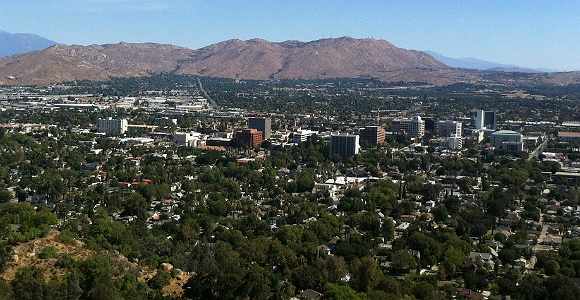
Downtown Riverside, California. (Photo Credit: Jason Stajich/Flickr)
The Inland Empire along with the rest of California received some encouraging news about tackling the problem of having the right workforce for the jobs that exist right now. At the same time, we’ve been taking a look back at some of our coverage of the Inland Empire, including workforce stories on the opening of a new medical school and a leadership academy for Latinos.
The first bit of good news were inside the Governor’s just-proposed budget which gives a boost to the Summit agenda in the form of $1.2 billion injected into workforce training programs.
Just a few days later, the California Economic Summit released its Roadmap to Shared Prosperity which makes the case for similar upgrades to California’s workforce by aligning training programs with what’s needed by the communities and industries in each region. That also means finding a better, long-term stream of funding for career tech and career pathways programs in good-paying, in-demand job fields.
One of those in-demand fields is the health care industry. The need for healthcare workers in the next ten years will be acute due to an aging and growing population. That worker deficit could reach the hundreds of thousands statewide.
In the Inland Empire, the doctor shortage is particularly severe and the doctor-patient ratio is one of the worst in the country. A California HealthCare Foundation report from 2009 found that Riverside County had 99 doctors per 100,000 people, compared to the state average of 174 doctors.
Not only does this affect the health of the workforce, the problem represents the opportunity cost of not filling high-paying jobs that come with opening up medical offices.
We made a visit last year to the new UC Riverside medical school, which had just started its first cohort the previous year, to talk to students, the school’s dean, and state Assembly member Jose Medina (D-Riverside) about what the institution means to the region’s economy.
VIDEO: Inland Empire economy to get boost from UCR med school
Also of concern for the region is the educational attainment and leadership skills of the population. At the same time, the Latino representation in the counties in the area have reached almost half of that population. Those are two of the reasons why Paul Granillo and the Inland Empire Economic Partnership created the Inland Empire Latino Leadership and Policy Institute, as we wrote in our story “Regional innovations – Inland Empire: How to build out the Latino talent pipeline.”
In the last year, Granillo’s group has taken an important step toward meeting this leadership challenge by creating the first-of-its-kind Inland Empire Latino Leadership and Policy Institute.
The institute, one of eleven regional innovations recently profiled in a California Stewardship Network report, aims to do this by tackling what Granillo views as his region’s preeminent challenge: The Inland Empire has the fourth largest Latino population in the country—behind only Los Angeles, New York, and Houston. And while Latinos will soon make up more than half the population, less than 8 percent of Latino adults have a bachelor’s degree.
Until the Inland Empire region—and California as a state—develops a plan for improving Latino college completion rates, Granillo believes, it will struggle to build a lasting economic foundation. “We have a blue-collar workforce, one dependent on manufacturing and goods movement and construction when it comes back,” Granillo says of the Inland Empire. “Latinos are the fastest growing demographic in the region, and they have the lowest education attainment rates. We can’t have a sustainable workforce without focusing on Latino student success.”

